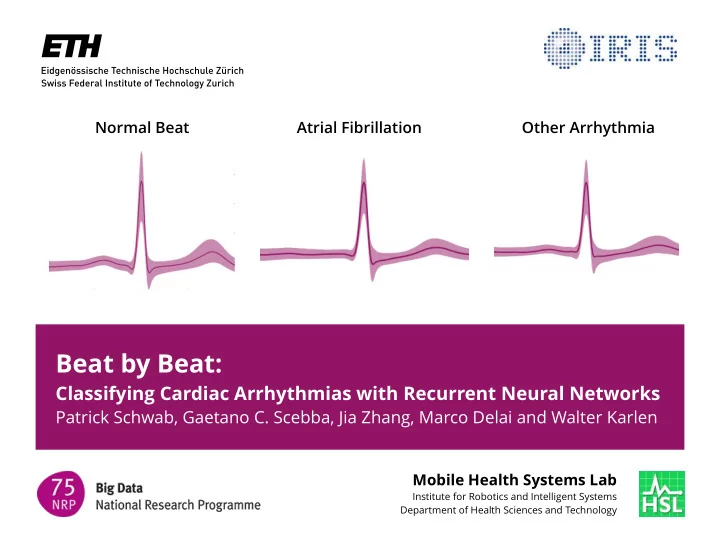

Normal Beat Atrial Fibrillation Other Arrhythmia Beat by Beat: Classifying Cardiac Arrhythmias with Recurrent Neural Networks Patrick Schwab, Gaetano C. Scebba, Jia Zhang, Marco Delai and Walter Karlen Mobile Health Systems Lab Institute for Robotics and Intelligent Systems Department of Health Sciences and Technology
Bonus Challenge Black Box Models Input Magic? Classi fi cation 2
Bonus Challenge Black Box Models Input Magic? Classi fi cation Classi fi cation Based on what? 3
Pipeline Level 1 Level 2 ECG Preprocessing Features Classi fi cation Models Blender RNN 1 Normal Extract AF ... Segment Normalise Blend Features Other Noise RNN n 4
Capturing the Temporal Dimension • Idea: Sequence learning over Heartbeats • Utilise natural heartbeat segmentation • From ~9000 time steps to just ~45 time steps for each record. • Allows us to relate decisions to individual heartbeats. Level 1 Level 2 Preprocessing Features Classi fi cation Models Blender RNN 1 Normal Extract AF ... Normalise Segment Blend Features Other Noise RNN n 5
Features • For each heartbeat , we extract: st • 𝜀 RR with (n-1) heart beat • Relative Wavelet Energy (RWE) on 5 frequency bands • Total Wavelet Energy • R Amplitude • Q Amplitude (relative to R) • QRS-Duration • Wavelet entropy (WE) • Low-dimensional embedding of morphology Level 1 Level 2 Preprocessing Features Classi fi cation Models Blender RNN 1 Normal Extract AF ... Normalise Segment Blend Features Other Noise RNN n 6
Level 1 Models • We train several base models in varying con fi gurations: • 1-vs-k and 1-vs-1 binary classi fi cation • Subsets of features • Di ff erent hyperparameters and model architectures • In order to learn a diverse set of base models that complement each other Level 1 Level 2 Preprocessing Features Classi fi cation Models Blender RNN 1 Normal Extract AF ... Normalise Segment Blend Features Other Noise RNN n 7
Attention over Heartbeats u t … hidden representation of h t W beat , b beat … single-hidden-layer multi-layer perceptron (MLP) u beat … hidden representation of most informative beat a t … attention factors c … context vector Bahdanau, D., Cho, K., & Bengio, Y. (2014). Neural machine translation by jointly learning to align and translate. 8
Attention (Sinus Rhythm) Normal: 94 % Normal vs. all a t ECG (s) 9
Attention (Sinus Rhythm) Typical pattern: Roughly equally weighted - all beats equally informative. Normal: 94 % Normal vs. all a t ECG (s) 10
Attention (Other Arrhythmia) Other vs. all Other: 67 % (s) 11
Attention (Other Arrhythmia) Almost exclusive focus on irregular heartbeat. Other vs. all Other: 67 % (s) 12
Results 13
Confusion Matrix (Validation Set) Predicted Class Normal AF Other Noisy Normal 86,53 % 0,96 % 11,53 % 0,96 % Actual Class AF 6,89 % 79,31 % 13,79 % 0,00 % Other 18,08 % 7,44 % 73,40 % 1,00 % Noisy 0,00 % 0,00 % 18,18 % 81,81 % 14
Confusion Matrix (Validation Set) Room for improvement! Predicted Class Normal AF Other Noisy Normal 86,53 % 0,96 % 11,53 % 0,96 % Actual Class AF 6,89 % 79,31 % 13,79 % 0,00 % Other 18,08 % 7,44 % 73,40 % 1,00 % Noisy 0,00 % 0,00 % 18,18 % 81,81 % 15
F1-Scores Validation Set Private Test Set P2 (20%) (PhysioNet 2017) F 1,Normal = 0.88 F 1,Normal = 0.90 F 1,AF = 0.75 F 1,AF = 0.78 F 1,Other = 0.72 F 1,Other = 0.68 F 1,Noisy = 0.78 — ——————— ——————— F 1,Total = 0.78 F 1,Total = 0.79 16
Conclusion ➔ Decisions that are communicable increase trust in automated systems. ➔ In order to create novel insights from large datasets, we need to understand what our models learn. ➔ We can and should have it all: The classi fi cation performance of a deep-learning model and comprehensible decisions. 17
Questions? Schwab et al. (2017). Beat by Beat: Classifying Cardiac Arrhythmias with Recurrent Neural Networks. Computing in Cardiology Conference (CinC 2017), Rennes, France, September 24-27, 2017 Patrick Schwab Mobile Health Systems Lab Institute for Robotics and Intelligent Systems Department of Health Sciences and Technology ETH Zurich patrick.schwab@hest.ethz.ch Follow me on Twitter: @schwabpa 18
Appendix 19
Level 2 Blender • Combine predictions from base models into fi nal classi fi cation score • Increasing overall accuracy by combining multiple models’ outputs • Using a multi-layer perceptron (MLP) Level 1 Level 2 Preprocessing Features Classi fi cation Models Blender RNN 1 Normal Extract AF ... Normalise Segment Blend Features Other Noise RNN n Koren, Y. (2009). The BellKor Solution to the Net fl ix Grand Prize. Net fl ix prize documentation , 81 , 1-10. 20
Recommend
More recommend